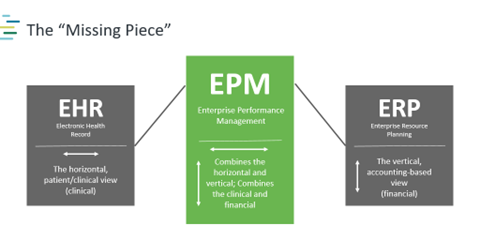Enterprise Performance Management: The Missing Puzzle Piece in Healthcare IQ
February 1, 2023
In the past half century, hospitals have been using a variety of healthcare information technologies to help them make better financial and clinical decisions. In recent years, hospitals and healthcare organizations have not felt fully supported by their decision support software. Many hospital leaders have cited a need for more industry-specific decision support solutions, among the handful of popular vendors available. The gap has left healthcare leaders struggling to make confident and strategic decisions for a unique, complicated industry.
Drifting away from traditional health systems
Today’s healthcare organizations suffer significantly from using outdated decision support applications offered by popular vendors in the market. These applications can’t offer providers access to trusted data their teams need to make informed decisions. Many provider organizations have already invested in Electronic Health Records (EHRs) and are either in the process of or have already deployed a cloud-based enterprise resource planning system. These two provide a foundation for their clinical, supply chain and human resource processes. There is a clear gap and disconnect between the two forms of information technology. Healthcare leaders are now transitioning from using these outdated systems to investing in new healthcare information technology that will help them bring their operating margins back up.
Evolution of EHR in Healthcare
An EHR is an electronic version of a patient’s medical history that is updated by their provider over time. An EHR provides information such as: patients demographics, health problems, laboratory, data, radiology reports as well as medications and immunizations. All of patients’ healthcare data is kept under one tool to support delivering quality care for patients. Before HER’s were created all of patient’s information was kept in files. Not only was this a tedious task but it also left a lot of room for errors and the inability to share information between hospitals in real time. In the mid-1960s Lockheed developed what is known as the clinical information system to help alleviate the problems of record keeping patients’ information. Other technology and engineering companies then further developed Lockheed’s electronic system which eventually led to the federal government using what is known as EHR during the 1980s.
ERP vs EPM
ERPs have an accounting-based/financial view. They manage business processes and transactions including accounting, supply chain, human resource activities, reporting and manufacturing. In the 1960’s manufacturing industries became aware that they needed a system that manages, monitors and controls their inventory. This resulted in the creation of Inventory Management and Control systems. The system was then changed a couple times between the 1960s until the 1990’s when it became known as an ERP and was widely used by The Gartner Group. ERPs are tremendously important and crucial for healthcare organizations. Unfortunately, current ERP applications on the market are designed and used across multiple industries. Healthcare systems have struggled finding an ERP that is healthcare focused and will meet and understand their unique system needs.
What Does Enterprise Performance Management Stand For In Healthcare?
Healthcare organizations can think of it like this: the EHR system offers a horizontal, clinical view of patients, while the ERP system provides a more vertical, financial view of accounting-based information. With such a wealth of data, healthcare providers could provide their frontline and operational staff with information and insights to improve clinical and financial outcomes. While these systems form the foundation to support a healthcare organization’s clinical and operational workflow, their lack of integration leaves behind a missing piece in the equation.
To make the connection between these two disparate views, healthcare leaders need access to a tool that can help smart people make smart decisions using clinical and financial data. Today, a new category is emerging for healthcare: the Enterprise Performance Management system. By deploying cloud-based Enterprise Performance Management (EPM) systems, providers can drive performance and transform their organization in many areas.

Multiple leading healthcare organizations have already adopted a cloud-based enterprise performance management system and have seen multiple positive impacts reflected on their organization. Our next blog in our Enterprise Performance Management blog series will dive into why healthcare organizations need an EPM as well as the steps needed to have a strong foundation in place to effectively adopt this platform.
Why Have Leading Healthcare Organizations Switched to Strata?
With a network of 400+ health systems and 2,000+ hospitals, we bring a unique set of software and service solutions to help healthcare providers better analyze, plan and perform. Our team had been trusted by highly recognized healthcare organization across the nation including: Kaiser Permanente, Cleveland Clinic, Intermountain and many others whom you can network with and share best practices. For over 20 years, Strata has been 100% dedicated to healthcare in everything we do every single day. Our platforms supports healthcare customers in cloud for longer than any other solution in the market with the highest level of security – HITRUST certified.